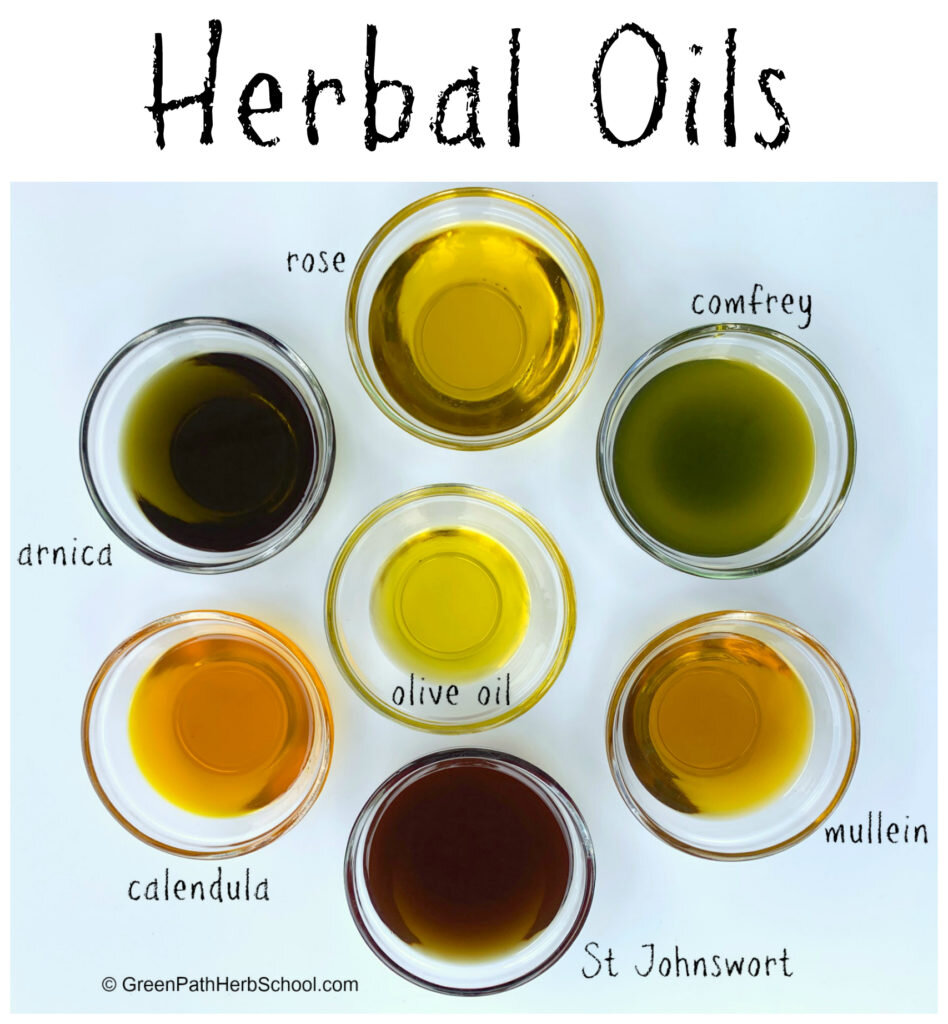Making Herbal Oils
Herb Infused Oils
Herbal oils are herbs that have been infused into vegetable or nut oils, also called fixed oils. Herbal oils have many healing benefits. They can be used by themselves for massage, added to foods, or combined to make other products. They can be used as ingredients in salves, lotions, ointments, hair oil, lip balms, suppositories, creams, and the list goes on! It is helpful to make some herbal oils to have on hand for your herbal apothecary. Although you can combine herbs together to make an oil, I usually prefer making each herb into a separate infused oil and then combining them as desired for different formulas.
Herbal Oil Uses:
Aches and pains
Aromatic chest rubs
Arthritis
Bruises
Contusions
Cracks in the skin
Dermatitis
Dry cuticles
Dry skin
First aid
Food: salad dressing, mayonnaise, marinade (make sure all oils and ingredients are edible)
Hair products (very small amounts; especially suited to curly or thick hair and men’s facial hair)
Hemorrhoids
Massage
Rashes
Shingles
Skin irritations
Sore nipples (for nursing mamas – leave out essential oil and wash well before nursing)
Splinters
Sprains
Sore muscles
Stretch marks (preventive measure)
To help support restful sleep (apply before bed)
When Not to Use an Herbal Oil:
Herbal oils are wonderful for so many healing purposes, but there are instances when they are best avoided. Occasionally, with an injury such as a burn, it is best to wait until the initial "hot" phase is over. Here are some times when it is best to avoid herbal oils:
Animal bites
Deep cuts
Large or deep wounds
New burns or sunburns
Puncture wounds
Second or third-degree burns (until the skin has regrown)
Uncleaned wounds
Best Practices:
Herb infused oils have a protective aspect to them and are helpful to apply before exercise as they hold in warmth for muscles and joints. They are also protective of the skin, helping to retain moisture and keep the acid mantle of the skin healthy.
Working internally as well as externally will usually speed the healing process. I find that using herbs internally, along with diet and lifestyle changes often encourages skin health and function.
Although not necessary, essential oils can help preserve your herbal oils and provide their own healing properties. Add 10–12 drops per ounce of oil.
Note: The quality of the herbs, fixed oil, and essential oils used to extract the herbs is very important: Always use high-quality herbs and fresh, cold-pressed, fixed oils. My favorite oil to use is extra virgin olive oil. A well made herbal oil should be infused with the color of the herbs used.
Making Herbal Oils:
Below, I describe how to make both fresh and dried herbal oils. I recommend making herbal oils out of dried herbs whenever possible to lessen the chance of mold or bacterial growth. Luckily, most herbs, in my opinion, are best used dry. Make sure all your medicine making tools are clean, sterilized, and dry when you start.
Ingredients:
Extra virgin olive oil
Natural Vitamin E oil (To determine this, look for “d-alpha” on the label.)
Benzoin gum
Essential oils (if desired)
Herb of your choice
You Will Need:
Scale
Measuring cup
Measuring spoons
Blender or food processor for dry plants
Snips or knife for fresh herbs
Jar with a tight-fitting lid (for dry herbs), or muslin cloth or paper towel (for fresh herbs)
Slow cooker, yogurt maker, oven, or black construction paper if desired
Strainer
Bowl
Herb Press (optional for dry plant oils)
Directions to Make a Dry Plant Oil:
Use 1 part dried herb by weight to 5-7 parts oil by volume. Generally, if an herb is light and fluffy, it may need a bit more oil to cover it. An example would be 2 ounces of echinacea flowers and 14 ounces of olive oil. I like to use extra virgin olive oil as it has its own healing properties for the skin and will infuse well with herbs.
Alcohol Intermediary method: Thanks to my teacher, Michael Moore for this method. Some herbs will be better extracted by using an alcohol intermediate. My favorite way to do this is by putting ethyl alcohol (such as Everclear) in a spray bottle. Spray the herbs gently, without getting them too wet. Let them sit overnight in a sealed container. Then add your fixed oil. This can be helpful for many herbs. Some herbs I find this method works well with include: Calendula, Chaparral, Oregon grape root leaf, and Poplar bud. I have even used this method to quickly make a fresh plant oil.
Blend the herbs and oil in a blender or food processor until the oil just starts to get warm. This helps the herb infuse into the oil. Some people prefer to heat their oils at a very low temperature in a slow cooker, yogurt maker, or oven. I don’t like setting my oils in the sun, as light and heat oxidize oils and they go rancid faster. To remedy this, you can wrap your jar in black paper before setting it in the sun. Make sure your oil is covering your herb. Add extra oil if necessary.
You can help your oil infuse by shaking or stirring it once a day.
Let your oil infuse (also called macerate) for one month.
Once it is ready, put a strainer in a bowl and line it with a muslin cloth. Pour your oil through the cloth and let it strain. To get any excess, squeeze the herb by hand or press it out with an herb press. Compost your spent herb.
To preserve your oil, you can add benzoin gum (1/2 ounce by weight of the powdered gum for every 32 fluid ounces of oil). You can also add natural Vitamin E oil (look for “d-alpha” on the label) (1 teaspoon Vitamin E oil for every 32 fluid ounces of herbal oil. Essential oils will also help preserve your herbal oils and provide their own healing properties. Add 10–12 drops per ounce of oil.
Dry plant oils have a shelf life of 1–2 years. Store your oil in a glass jar in a cool, dark place such as the refrigerator or a cupboard.
Dry Herb Examples: Calendula (Calendula officinalis), Cayenne (Capsicum annuum), Chamomile (Matricaria chamomilla), Chaparral (Larrea tridentata, Comfrey (Symphytum officinale), Echinacea (Echinacea spp.), Figwort leaf (Scrophularia spp.), Ginger (Zingiber officinalis), Gotu Kola (Centella asiatica), Lavender (Lavandula spp.), Marshmallow leaf or root (Althea officinalis), Mullein leaf (Verbascum thapsus), Oregon grape root leaf (Mahonia spp.), Plantain (Plantago spp.), Poplar bud (Populus spp.), Rose petal (Rosa spp.), Sage (Salvia officinalis), Self Heal (Prunella vulgaris), Yarrow (Achillea millifolium) and Witch Hazel (Hamamelis spp.)
Directions to Make a Fresh Plant Oil:
Wilt herbs in a dark, cool place (paper bag or screen) for several hours or overnight to reduce their water content.
Use 1 part herb by weight to 3-4 parts oil by volume. An example of this would be 2 ounces of garlic to 8 ounces of olive oil.
Chop the herb well before adding the oil. Do not grind or blend it.
Make sure the herb is completely covered in oil. Parts that stick out will tend to mold. Add extra oil if necessary.
Cover the jar with a paper towel or cheesecloth to allow moisture from the herbs to evaporate. This is a crucial step to prevent mold. I have even heard of jars exploding when this step is not followed.
Infuse (also called macerate) for 1 month in a cool dark place. St. John’s wort needs to be warmed, which can be done by putting it in the sun (wrap black construction paper around the jar first to protect it from the light), or baked in an oven or cooked in a slow cooker for 2 hours on the lowest heat.
Once it is ready, put a strainer in a bowl and line it with a muslin cloth. Pour your oil through the cloth and let it strain.
To avoid getting moisture from the plant into the oil, squeeze fresh plant oils out by hand through a muslin cloth or cheesecloth. If you do get water into your oil, decant as needed to remove it. Water will sink to the bottom of the jar and not incorporate it with the oil. It can cause mold.
To preserve your oil, you can add benzoin gum (1/2 ounce by weight of the powdered gum for every 32 fluid ounces of oil). You can also add natural Vitamin E oil (look for “d-alpha” on the label) (1 teaspoon Vitamin E oil for every 32 fluid ounces of herbal oil.
Fresh plant oils have a shelf life of up to one year or more. They are best refrigerated.
Fresh Herb Examples: There are only a few herbs I would recommend using fresh, due to their fragile nature. Arnica (Arnica spp.), St. John’s Wort (Hypericum perforatum), Chickweed (Stellaria media), Dandelion flower (Taraxacum officinale)
Calendula oil
Herbal Oil Recipes:
Skin Soothing Oil:
1 ounce calendula oil (Calendula officinalis)
1 ounce marshmallow leaf oil (Althea officinalis)
1 ounce comfrey leaf oil (Symphytum officinale)
1 ounce chamomile flower oil (Matricaria chamomilla)
1 capsule natural Vitamin E oil
This formula is healing to the skin and will help repair, protect, and soften. Add all oils together and store in a dark glass jar with a tight-fitting lid. Label and have a small, glass bottle on hand. Store extra oil in the refrigerator. Use Skin Soothing Oil for rashes, dry skin, stretch marks, cuticles, hemorrhoids, and cracks in the skin.
Rose Face Oil:
1 ounce rose infused oil (Rosa spp.)
½ ounce rosehip seed oil (Rosa moschata or Rosa rubiginosa)
½ ounce jojoba oil (Simmondsia chinensis)
4 drops rose essential oil (Rosa spp.)
1 capsule natural Vitamin E oil
This recipe is rich and hydrating with an amazing aroma. Add all oils together and store in a dark glass jar with a tight-fitting lid. Label and have a small, glass bottle on hand. Store extra oil in the refrigerator. After washing the face, apply a gentle face toner and then apply Rose Face Oil to the face and neck, rubbing gently.
Sore Muscle Massage Oil:
1 ounce Arnica oil (Arnica spp.)
1 ounce St. John's Wort Oil (Hypericum perforatum)
½ ounce Poplar bud oil (Populus spp.) (see recipe on tree medicine article)
½ ounce Figwort oil (Scrophularia spp.)
½ ounce Cayenne oil (Capsicum annuum)
1 capsule natural Vitamin E oil
Add all oils together and store in a dark glass jar with a tight-fitting lid. Label and store extra oil in the refrigerator. An anti-inflammatory and rubefacient blend, this oil can be used to massage into sore muscles, achy joints, bruises, sprains, and arthritic joints.
Green Cooking Oil:
2 teaspoon dried Nettles (Urtica dioica)
1 teaspoon dried Rosemary (Rosmarinus officinalis)
1 teaspoon dried Thyme (Thymus vulgaris)
1 teaspoon dried Sage leaf (Salvia officinalis)
1 teaspoon dried Dandelion leaf (Taraxacum officinale)
1 teaspoon dried Basil (Ocimum basilicum)
1 teaspoon dried Parsley (Petroselinum crispum)
1 teaspoon freshly ground Black Pepper (Piper nigrum)
1/8 teaspoon cayenne (Capsicum annuum)
1 capsule natural Vitamin E oil
1 cup extra virgin olive oil
Although they can be made separately, I like to mix these herbs all together to make this oil. This recipe will make a thick oil and you can leave the herbs in the oil or strain them out as you prefer. I prefer it unstrained and like to put it in a wide mouth jar and use a spoon to get all the herbal goodness. This Herbal Cooking Oil is highly nutritious, antioxidant, and will help aid digestion. It can be used for baking vegetables or meats, or as an ingredient in salad dressing, mayonnaise, marinades, and more!
© Elaine Sheff, Clinical Herbalist, RH (AHG)




